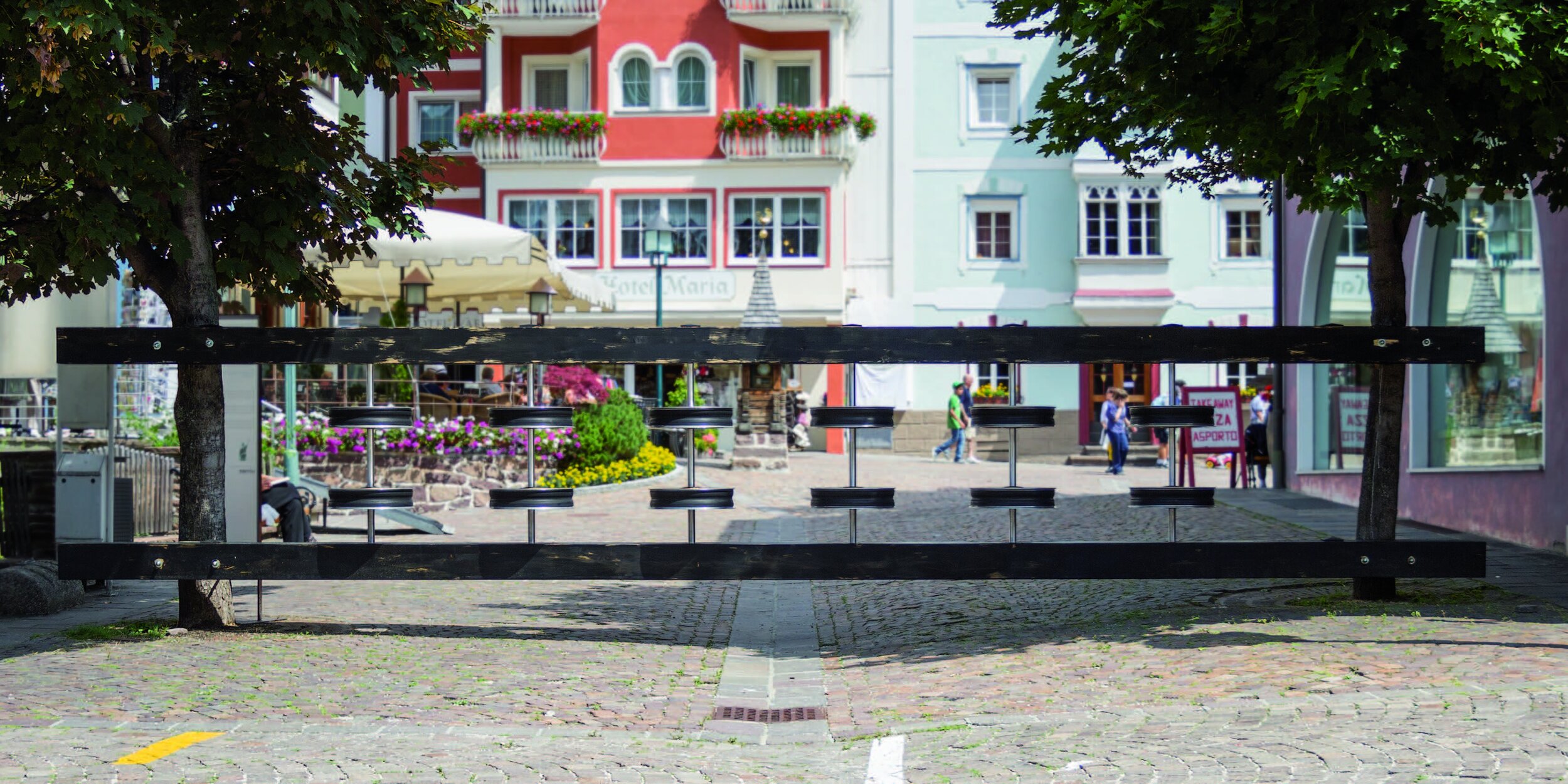
Hubert Kostner
*1971, Italy
lives and works in Castelrotto, Italy
EN
In his sculptural works and installations, his actions and interventions in public space, Hubert Kostner deals ironically and enigmatically with the occupation and consequent appropriation of spaces, especially natural spaces and their architectural and topographical appropriation. The artist is a keen observer of touristically developed areas in the Alps and their clichéd perception; he examines the effects of mass tourism and the leisure industry in a nature made user-friendly by infrastructural interventions. Natural landscapes are conquered and territorially appropriated; instead of a romantic, sublime view of nature, the view of a medialised and easily consumable landscape takes its place. Kostner's artworks enable surprising changes of perspective through contextual shifts and alienations of size and dimension. Parodistic allusions do not make his works appear too serious, but precisely for this reason they never fail to have an effect.
In his mostly small-format sculptures and paintings, Hubert Kostner takes landscape observations of his immediate surroundings as a starting point and alienates them in model-like experimental arrangements. In his actions and works in public space, Kostner consistently reacts to site-specific conditions. Kostner's installation consists of a dozen pulleys from a lift system, which are threaded onto vertical poles and fixed to two existing trees via wooden beams. The work blends wonderfully into its surroundings, acting as a demarcation between the pedestrian zone and the street behind it, with the cable car to the Alpe di Siusi visible in the background. The lift wheels are painted gold on the inside. Kostner asks visitors to turn them and make a wish. In this way, the artist makes us aware of the aesthetics of a commodity, the lift wheels become a sculpture with a participatory moment. In a mixture of lift system, Tibetan prayer wheel and playground equipment, Kostner explores the boundaries of the concept of sculpture; by shifting the context, he questions the function and form of the lift wheels and irritates us with their newly assigned function.
IT
Con i suoi lavori scultorei e le sue installazioni, le azioni e gli inter-venti nello spazio pubblico, Hubert Kostner tratta in maniera ironica ed enigmatica l’occupazione e la fruizione degli spazi, soprattutto quello naturale, e il relativo sfruttamento architettonico e topografico. L’artista è osservatore acuto dei paesaggi alpini sfruttati turisticamente e della loro percezione stereotipata. Kostner analizza gli effetti del turismo di massa e dell’industria del tempo libero sulla natura resa a “misura d’uomo” attraverso interventi infrastrutturali. I paesaggi naturali vengono conquistati e occupati territorialmente; la prospettiva romantica e sublime della natura è soppiantata da uno sguardo che vede un paesaggio medializzato e facilmente consumabile. Le opere di Kostner permettono, grazie a meccanismi di decontestualizzazione e attraverso lo straniamento delle dimensioni, sorprendenti cambi di prospettiva. Allusioni parodistiche danno un tocco di leggerezza alle sue opere, ed è proprio per questo motivo che i suoi lavori non falliscono mai lo scopo.
Nelle sue sculture e nei suoi quadri di piccolo formato, Hubert Kostner parte dall’osservazione paesaggistica dei dintorni e li modifica in senso modellistico. Le sue azioni e i suoi lavori nello spazio pubblico si adattano sempre alle condizioni specifiche del luogo. L’installazione di Kostner è composta da una dozzina di rulli di una seggiovia fissati a delle stanghe verticali, fermate a delle travi poste tra due alberi. L’opera si inserisce perfettamente nel contesto urbano, fungendo da elemento divisorio tra la zona pedonale e la strada retrostante; alle spalle si intravede in lontananza la ovovia dell’Alpe di Siusi. Kostner invita i passanti a far girare i rulli, laccati d’oro al loro interno, e ad esprimere un desiderio, rendendoci così anche consapevoli dell’estetica di un oggetto d’uso. In questo processo, i rulli diventano una scultura cui è proprio un momento partecipativo. Con un’opera a metà strada tra l’impianto di risalita, il mulino da preghiere tibetano e il giocattolo per bambini, l’artista intende scandagliare i confini della scultura; attraverso la decontestualizzazione pone domande circa la funzione e la forma dei rulli, non senza provocare una certa irritazione dovuta alla nuova funzione attribuita loro.
DE
Hubert Kostner setzt sich in seinen skulpturalen Arbeiten und Installationen, seinen Aktionen und Interventionen im öffentlichen Raum ironisch wie hintergründig mit der Besetzung und infolge Inbesitznahme von Räumen auseinander, insbesondere von Naturräumen und ihrer architektonischen und topografischen Vereinnahmung. Der Künstler ist ein scharfer Beobachter von touristisch erschlossenen Gebieten im alpinen Raum und ihrer klischeehaften Wahrnehmung, er untersucht die Auswirkungen von Massentourismus und Freizeitindustrie in einer durch infrastrukturelle Eingriffe benutzerfreundlich gemachten Natur. Naturlandschaften werden erobert und territorial vereinnahmt, anstelle einer romantischen, erhabenen Sicht auf die Natur tritt der Blick auf eine medialisierte und leicht konsumierbare Landschaft. Kostners Kunstwerke ermöglichen durch Kontextverschiebungen und Verfremdungen von Größe und Dimension überraschende Perspektivenwechsel. Parodistische Anspielungen lassen seine Werke nicht allzu ernst erscheinen, doch gerade deshalb verfehlen sie nie ihre Wirkung.
In seinen meist kleinformatigen Skulpturen und Bildern geht Hubert Kostner von landschaftlichen Beobachtungen seiner unmittelbaren Umgebung aus und verfremdet sie in modellartigen Versuchsanordnungen. Bei Aktionen und Arbeiten im öffentlichen Raum reagiert Kostner konsequent auf ortspezifische Gegebenheiten. Kostners Installation besteht aus einem dutzend Seilrollen einer Liftanlage, die auf senkrechten Stangen aufgefädelt wurden und über Holzbalken an zwei bestehenden Bäumen fixiert sind. Die Arbeit fügt sich wunderbar in ihren Umraum ein, sie wirkt wie eine Abgrenzung zwischen Fußgängerzone und dahinter liegender Straße, im Hintergrund ist die Seilbahn zur Seiser Alm sichtbar. Die Lifträder sind innen goldfarben lackiert. Kostner fordert die Besucher auf, diese zu drehen und sich dabei etwas zu wünschen. Der Künstler macht uns so die Ästhetik eines Gebrauchsgegenstandes bewusst, die Lifträder werden zu einer Skulptur mit partizipativem Moment. In einer Mischung aus Liftanlage, tibetischer Gebetsmühle und Spielplatzgerät lotet Kostner die Grenzen des Skulpturenbegriffes aus, durch die Kontextverschiebung hinterfragt er Funktion und Form der Lifträder und irritiert mit der ihr neu zugewiesenen Funktion.
